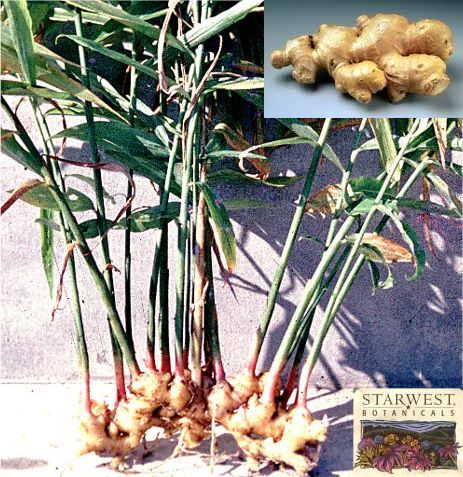
(scientific name: Zingiber officinale)
It is botanically not a root but a rhizome of the monocotyledonous perennial plant. It has many uses as a medicinal herb with antifungal, anti-inflammatory, antibiotic, antiviral, diuretic and antiseptic properties.
Properties
• Extracts and active constituents have shown potent antioxidant, antiinflammatory, antimutagenic, antimicrobial and possible anticancer activities.
• Considered adaptogenic, anodyne, anthelmintic, antiallergenic, antibacterial, anticoagulant, anticonvulsant, antidepressant, antifungal, antithrombotic, antitumore, antiulcer, aphrodisiac, carminative, diuretic, rubifacient, anti-platelet aggregation, hypolipidemic, thermoregulatory.
• Pungency is attributed to the pungent principle, zingerone and shogaol, while the aroma is imparted by the volatile oil.
• Considered stomachic, carminative, stimulant, diaphoretic, sialagogue, and digestive.
Parts utilized
Tops, leaves and edible roots.
Uses
Flavoring for confectioneries, ginger ale, ginger beer, ginger champagnes, and other beverages.
- Salabat, a native beverage, is prepared from the rhizomes.
- A prominent condiment in Filipino cuisine.
- Taken with rocksalt before meals is cleansing to the tongue and throat and increases the appetite.
- In Malaya fresh ginger is an important ingredient in curry.
Folkloric
- In the Philippines, pounded rhizome, alone or mixed with oil, used as revulsive and antirheumatic.
- As antiseptic, tincture of dried rhizome prepared with 70% alcohol (not rubbing alchol) and applied on superficial cuts and wounds; or, juice from fresh rhizome used similarly.
- As digestive aid and for flatulence and tympanism, decoction of the rhizome drunk as tea.
- Ginger juice rubbed on and around the navel is said to cure all kinds of diarrhea.
- For rheumatism, roasted rhizome is pounded and mixed with oil and applied locally.
- For sore throat and hoarseness, warm decoction of the rhizome is drunk as ginger tea (salabat); piece of small rhizome chewed for the same.
- Rhizome used as cough remedy, rubifacient, carminative and diuretic.
- Also used for hangovers.
- For chronic rheumatism, ginger infusion ( 2 drams in 6 ounces of boiling water and strained) is taken at bedtime
- Poulticed of pounded and warmed leaves applied to bruises.
- Ginger taken with rock salt before meals is said to clean the tongue and throat and increase the appetite. Chewing ginger is said to diminish biliousness and delirium, relieve sore throat, hoarseness and aphonia, and increases the flow of saliva.
- For headaches: Ginger plaster (bruised ginger in water to the consistency of poultice) is applied to the forehead. Same preparation may be helpful for toothaches and facial pain.
- In Indo-China, cataplasm used for furuncles; when mixed with oil is antirheumatic. Rhizomes also used for tuberculosis, general fatigue and uterine affections.
- In Perak, rhizomes used as vermifuge.
- In the Antilles powdered rhizome used as revulsive for pleuritis.
- In Ayurvedic medicine, used for inflammation and rheumatism.
- In India, used as carminative adjunct along with black pepper and long pepper.
- In Chinese folk medicine, pulverized fresh ginger used for baldness and vitiligo. Juice from fresh root used for treatment of burns.
New uses
• Motion Sickness / Pregnancy-related Nausea: Antiemetic properties. Used for Nausea, motion sickenss (1 gm taken 1/2 hour before the voyage). Stimulates digestion. Possibly antiinflammatory.
Side effects
• No known side effects or drug interactions.
• The German Commission E recommends that it be avoided during pregnancy due to possible inhibition of testosterone binding in the fetus.
• The use in pregnancy for hyperemesis gravidarum is controversial. Use for nausea during pregnancy is not recommended. • Should not be used by pregnant women with a history of bleeding disorders and miscarriages.
Anticogulang precaution
Decreases platelet adhesiveness; therefore, should be used with caution by patients on anticoagulant therapy.
Availability
Wild-crafted.
Popular condiment and perennial market produce.
Candied ginger and lozenges.
Dried powdered gingeroot.
Tinctures, tablets, capsules, syrups and teas in the cybermarket.
No comments:
Post a Comment